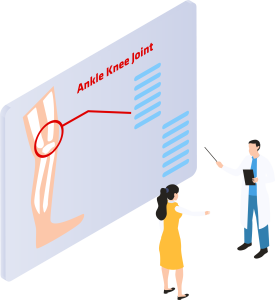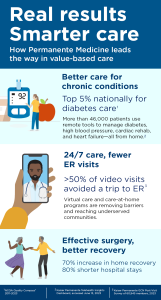Unlocking the potential of value-based care
Two key problems face health care delivery in America — cost and quality. Put simply, the U.S. spends twice as much on health care than comparable countries. Yet the U.S. as a whole has far worse health outcomes than many high-income nations across a variety of critical health measures. These measures include the lowest life expectancy at birth, highest maternal and infant mortality, highest rate of people with multiple chronic conditions, and an obesity rate that is nearly double the average.
Studies suggest that one of the keys to fixing the health care system lies in an approach that Kaiser Permanente pioneered in 1945: value-based care. Although variations of value-based care exist, they all tend to reward quality outcomes, emphasize population health management rather than episodic care, prioritize preventive care, and focus on the social determinants of health to increase equitable care. At the heart of Kaiser Permanente’s model is prepayment of integrated, comprehensive care. This means that groups of physicians and clinicians receive a defined payment to keep enrolled patients healthy.
Value-based care ultimately strives to deliver the best outcomes and care experiences, while fostering healthy behaviors and promoting preventive care to maintain overall well-being and contain costs for all.
Value-based care vs. fee-for-service care
The most common care delivery and financing model in the U.S. is fee-for-service. In this model, physicians and clinicians receive a fee for each visit, test, or procedure. While this approach has been around a long time, it is not yielding better outcomes. The limitations of fee-for-service include:
- Excessive or unnecessary visits, tests, and services, which drives up costs
- Lack of coordination and sharing of critical patient health information across providers, which lowers quality
- Lack of emphasis on patient-centered care, which makes for a poor care experience
- An increase in specialty care and hospitalizations, which, because they’re more profitable than prevention and primary care, drives up costs
Value-based care addresses each of these shortcomings, and in doing so, demonstrates an approach to health care that is ethical and compassionate. These qualities are critical to both patients’ satisfaction with their health care and physicians’ satisfaction with their careers.
The Centers for Medicare & Medicaid Services has been implementing several value-based care programs that incentivize providers to improve quality while reducing costs. Other efforts to implement programs that reward better outcomes rather than volume of procedures include accountable care organizations, patient-centered medical homes, performance-based payment providers, and pre-paid (capitation) models.
Despite this push to embrace different forms of value-based care, most physicians still practice in a fee-for-service setting, with few or no incentives to improve quality or reduce costs. A recent study found that only 31% of U.S. physicians are moving toward value-based care models. The same study also found that only 5.3% of health care delivery systems’ contracts are based on comprehensive population-based payment models, which reward physicians and clinicians based on a group of patients they care for in a value-based arrangement.
In short, this is a missed opportunity. We can align physician incentives with payer incentives through comprehensive, population-based models. Such models emphasize care coordination, efficient and effective care delivery, and patient outcomes.
More than a payment strategy
The integrated care and coverage model at Kaiser Permanente represents the most advanced form of population-based payment. Here, the multispecialty Permanente Medical Groups provide comprehensive clinical care, Kaiser Foundation Health Plan provides coverage, and Kaiser Foundation Hospitals operate the medical facilities. By integrating our services, we’re able to align incentives and goals across Kaiser Permanente. Coordinating efforts within the system enables us to create widescale care delivery, payment, and administrative efficiencies.
Prepayment for care allows for a focus on quality and efficiency, which optimizes outcomes. Payments don’t motivate our physicians and clinicians for each office visit, test, or service. Instead, they focus on working together to prioritize health screenings to prevent or catch diseases early. Doctors work with hospital and health plan leaders to develop systems to manage complex conditions seamlessly. Primary and specialty care teams collaborate on patient care and have real-time access to longitudinal, complete digital health records. This gives doctors the ability to coordinate care across different care settings — the hospital, the medical office, and the home — and modalities such as video or telephone visits, email, remote monitoring.
Establishing a culture of value-based care delivery
Kaiser Permanente’s model of prepaid, physician-led care and aligned incentives has demonstrated its effectiveness. Today, this model is among the nation’s most successful value-based care environments. At the care delivery level, this means establishing a culture of integration and continuous improvement that emphasizes primary care, prevention, disease management, and population health. Collaboration among doctors and clinicians and between primary care and specialty care ensures a coordinated and comprehensive strategy for managing complex conditions. This connection across disciplines allows care teams to achieve better health outcomes for individuals and communities alike, prevent health challenges before they arise, and ensure the application of evidence-based medicine effectively at scale.
This unique integrated approach to care — we call it Permanente Medicine — is enhanced by one of the nation’s leading clinical research programs. Physician researchers, statisticians and investigators, and operational staff work together to identify, review, and implement new evidence-based practices and innovations across the organization.
Related: Value-based care designed to deliver maximum cost savings
How to drive the industry to value-based care
A culture of medical excellence is only one foundational element that underpins a successful approach to value-based care. Additionally, value-based models should be patient-centered, embrace proven innovations and new technologies such as AI and telehealth, and commit to rooting out health inequities. Here’s how Permanente Medicine is accomplishing this:
Including patients in care decisions and personalized treatment plans
Patient-centered care focuses on people and their families, ensuring we meet their unique needs, which leads to better health outcomes and greater satisfaction. Each patient has a personalized treatment plan that is visible to them and the professionals who care for them. Patient-centered care also fosters trust between patients and physicians, improving the care experience for all.
Embracing long-term investments in technology and innovation
Twenty-five years ago, Kaiser Permanente implemented the largest civilian-operated electronic health records system in the United States. This system has evolved to integrate all aspects of care, including appointments, registration, billing, pharmacy, and lab services, providing a comprehensive view of each patient’s medical history. Today, Permanente physicians use tried and tested data analytics and artificial intelligence tools to measure and track outcomes, predict health risks, and assist in evaluating patient health information. This technology helps physicians identify areas for improvement and implement evidence-based practices quickly and more effectively.
Encouraging physicians to addressing the root causes of health inequities.
Through an effort led by our National Equity, Inclusion, and Diversity and Quality departments, we’re eliminating health disparities, reducing barriers to access, and addressing social determinants of health. One example: research published in The New England Journal of Medicine showed that a decade of enhanced screening for colorectal cancer with fecal immunochemical tests (FIT) essentially eliminated disparities between Black and white Kaiser Permanente members in Northern California and that organized screening improves colorectal cancer outcomes for all our members.
Watch this next:
Our model delivers results: chronic condition management and care at home
Kaiser Permanente’s chronic condition management program is one example of how our value-based model improves patient outcomes, enhances care, and achieves cost savings. Targeted, proactive outreach makes it easy for patients to schedule needed screenings and regular exams, while telehealth options help patients conveniently manage conditions such as diabetes and hypertension from their home.
In 2023, our HEDIS scores were among the top 5% of all commercial health plans nationally in eye exams, kidney health evaluations, and statin therapy for members with diabetes. HEDIS scores also reflected that we’re in the top 10% nationally for controlling high blood pressure, with a control rate of 74% versus 60%, according to Quality Compass results for 2011–2023. Better chronic condition management helps patients get the right care at the right time and minimizes unnecessary treatment and hospitalizations. Reducing unnecessary care and hospitalizations helps control costs, eliminates the stress and inconvenience of overtreatment, and reduces potential harm to patients.

Another example of value-based care in action is our advanced care-at-home program. Patients who would normally be admitted to a hospital but meet certain clinical criteria can have high-quality, acute-level care in the safety, comfort, and convenience of their own homes. Physician-led multidisciplinary care teams manage their care, supported by a robust health information technology platform. Patients have access to 24/7 care, including virtual office visits and remote monitoring devices, as well as home visits.
Care-at-home services also help advance health equity, especially for patients dealing with access issues, financial burdens, or both. Bringing care directly to people’s homes removes barriers to care and helps ensure that underserved communities get the medical care they need regardless of location or circumstance.
High quality at lower costs: Leading in same-day joint replacement and bilateral cataract surgery
Our highly successful joint replacement program shows how our integrated, coordinated model of care delivers on quality, safety, and cost-efficiency. Across all our regions, the proportion of patients undergoing same-day primary elective total hip or knee joint replacement increased from 7.2% in 2016 to 62% in 2019. Average hospital length of stay decreased by 0.93 days. During this time, more than 27,000 procedures that would have resulted in overnight hospital stays became same-day discharges. In 2021, our rate of same-day discharges had increased to 80% of total elective hip or knee joint replacements.
From 2016 to 2019, readmission rates averaged 5.5% for 7-day returns to care and 1.8% for 30-day readmissions. In addition, even after adjusting for patient, hospital, and surgical factors, both rates were lower among patients with same-day procedures than among those with longer hospital stays. And satisfaction with overall care and surgical outcome was higher among patients discharged the same day than among those with longer stays. In the U.S., same-day joint replacements are estimated to save $7,684 per patient.

Kaiser Permanente’s bilateral cataract surgery services also demonstrate the efficiency and efficacy of our value-based model. In the U.S., the vast majority of surgeons perform delayed sequential bilateral cataract surgery, which treats each patient’s eye days, weeks, or even months apart. This approach allows surgeons to bill for two surgeries, a practice incentivized by Medicare’s payment methodology. At Kaiser Permanente, patients who qualify clinically can choose immediate sequential bilateral cataract surgery, which lets surgeons remove both cataracts in immediately sequential yet separate surgical procedures on the same day.
Nearly half of our cataract patients prefer this option because it offers faster visual recovery, time saved returning for any pre- or post-surgery appointments, fewer instances of anesthesia, less time in a recovery room, fewer trips to the pharmacy for required eye drops, reduced copays, and reduced inconvenience of loved ones who take them to these visits.
How COVID-19 revealed the benefits of Kaiser Permanente’s approach
During the COVID-19 pandemic, many fee-for-service providers that depended on in-person visits struggled to stay in operation. However, value-based organizations that had invested in telehealth and remote patient monitoring before the pandemic continued seeing many patients remotely.
When the pandemic hit, Kaiser Permanente quickly pivoted services to telehealth so patients could get the care they needed. And we continue to identify ways to use virtual health such as virtual physical therapy, virtual cardiac rehabilitation, and electronic visits (e-visits). Most importantly, our integrated model and focus on prevention helped us to provide means for patients to get their medications and other urgent medical services easily and safely.
Related resource: Ramin Davidoff, MD, on the benefits of value-based care
Patient-centered care as a key benefit of value-based care
Recently, Kaiser Permanente scaled a new perinatal care program which offers remote hypertension monitoring with a blend of virtual and in-person care. This program led to increased screening rates for postpartum complications and higher patient satisfaction rates. This approach prioritizes choices and options, improving women’s health through a safe, blended model of care.
Called the Cocoon Pregnancy Care Program, this integrated, multidisciplinary approach to maternity care improves the quality of care mothers receive before, during, and after pregnancy. Significantly, it is also addressing the socioeconomic and access issues that many women face. A team of primary, maternal, and specialty care physicians, along with dietitians, behavioral health clinicians, nurses, and social workers, coordinate care at every stage of pregnancy to ensure the patient is always at the center of care.
A nationwide network of cancer care specialists
Kaiser Permanente has specialists for nearly every type of cancer, enabling advanced care when needed. Permanente Medical Group primary care doctors and cancer care teams can also consult with Permanente specialists throughout the U.S. to review complex cases and refine treatment plans.
Related: Value-based care spotlight
Value-based care at Kaiser Permanente as a model for the future of medicine in the U.S.
These advancements, along with countless others, are the result of more than 80 years of collaboration among physician, health plan, and hospital leaders to create a truly unique health care delivery system. At the heart of this model is a commitment to continuous innovation, supported and enhanced by our national, physician-led clinical research programs that are integrated with care delivery.
This model fosters and enables breakthroughs that not only advance value-based care, but also provide a roadmap to a more sustainable, equitable, and effective health care system. Delivering affordable, high-quality, integrated care to patients isn’t merely essential — it represents the future of health care.

